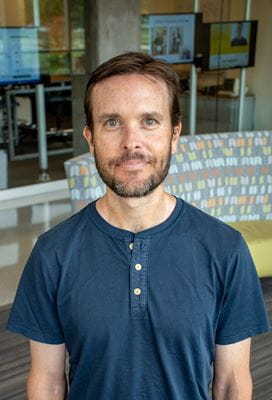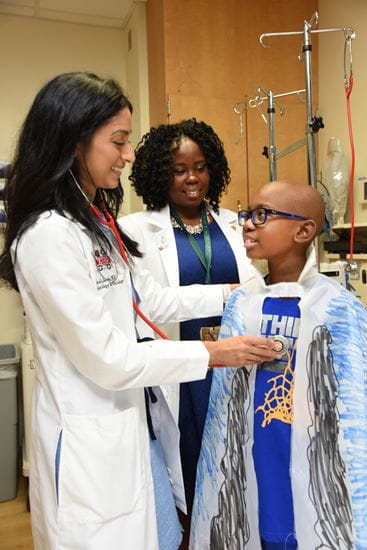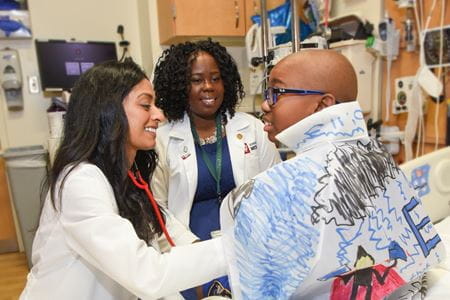Imagine being in severe pain with a chronic health condition and medical professionals delaying treatment or denying a pain medication for fear you are a “drug seeker.” This is the lived experience of many Black youth with sickle cell disease.
“Over time, if you repeatedly experience biases in health care, you develop a cognitive attribution for, ‘Why is this happening to me?’ Is it ‘because I’m Black,’ or ‘because I have sickle cell disease’ or ‘because I’m in pain’?” explained Amy Williams, PhD, associate professor of clinical psychiatry at Indiana University School of Medicine.
 Williams is launching a two-year study to examine how ‘injustice appraisals’—a patient’s perception of injustice in their medical care—affects the physical symptoms and mental well-being of youth ages 11 to 18 with sickle cell disease. Funded by the Indiana University Racial Justice Research Fund, the study aims to reduce racial disparities impacting the health care and lifelong morbidity of these youth by informing the development of interventions for both patients and providers.
Williams is launching a two-year study to examine how ‘injustice appraisals’—a patient’s perception of injustice in their medical care—affects the physical symptoms and mental well-being of youth ages 11 to 18 with sickle cell disease. Funded by the Indiana University Racial Justice Research Fund, the study aims to reduce racial disparities impacting the health care and lifelong morbidity of these youth by informing the development of interventions for both patients and providers.
“If we can intervene earlier, we can have a much more substantial impact to improve their mental health and physical health in the future,” said Williams, a pediatric psychologist who works at Riley Hospital for Children specializing in helping kids cope with chronic pain.
Her research team for this study includes Seethal Jacob, MD, MS, FAAP, assistant professor of pediatrics at IU School of Medicine and director of the Comprehensive Pediatric Sickle Cell Program at Riley, along with Adam Hirsh, associate professor in the Department of Psychology at IUPUI, who directs the IUPUI Pain Research Laboratory. Hirsh recently published a study exploring racial disparities in pain care using computer simulations to untangle the sociological influences of pain management.
 “There’s a long history of literature on racial disparities in pain care, and, historically, it is focused on Black patients with pain receiving fewer and less-potent opioids compared to white patients with pain,” Hirsh said.
“There’s a long history of literature on racial disparities in pain care, and, historically, it is focused on Black patients with pain receiving fewer and less-potent opioids compared to white patients with pain,” Hirsh said.
Sickle cell disease is a genetic condition affecting about 100,000 people in the United States, the majority of whom are Black. In a person with sickle cell disease, red blood cells become hard and sticky and look like a sickle (a C-shaped farm tool). The sickle cells die early, causing a constant shortage of red blood cells, and they can get stuck in blood vessels, clogging blood flow. This can lead to pain, infections, acute chest syndrome and stroke.
Children with sickle cell disease miss school often due to pain and other symptoms, sometimes leading to hospitalizations. As adolescents move closer to the age of independence, they often struggle to manage symptoms as they face the increasing demands of high school, navigate college and start their vocations.
“It’s hard not to want to help; it’s a rough condition,” Williams said. “The pain is very intense, and it can interfere with their ability to function.”
Add social stigmas to the equation, and quality of life can be greatly impacted.
“If you repeatedly tell somebody with sickle cell disease they are drug seeking or faking or not worthy of the treatment, eventually they start to believe that. It’s not their fault they believe that—it’s from their lived experience,” Williams said. “We want to help them change cognitive attributions that are not helpful for them.”
While injustices in treatment may be real or perceived, Williams’ goal is ultimately for her sickle cell patients to be happy and functioning. Cognitive behavioral therapy can be useful in helping these youth build resilience and mitigate negative health consequences over their lifetimes.
“There are physical, emotional and behavioral components of pain. If we can reduce the emotional and behavioral impacts of pain, then it can be less distressing,” Williams explained. “They may have pain the rest of their life, but our goal is to help them learn skills to cope with their pain so they can still do the things they want to do in life.”
There is work to be done on the side of health care providers as well. They may harbor unconscious bias toward the population most affected by sickle cell disease: African Americans. Increased self-awareness and enhanced training could prevent suboptimal care and delayed clinical care often experienced by sickle cell patients, Williams asserted in her study proposal.
Other studies on adults with sickle cell disease have shown that patients who perceived higher levels of injustice related to their treatment also experienced higher levels of pain and stress. Williams’ study addresses a gap in research on children and adolescents specifically with sickle cell disease.
“We know that for Black youth, in general, their pain is subject to bias and often assessed to be less urgent; there is less imaging done and fewer pain medications prescribed,” Williams added.
 The study will enroll 50 sickle cell patients ages 11 to 18, along with their parents or guardians, recruited from Riley Hospital and the Indiana Hemophilia & Thrombosis Center at St. Vincent Hospital, which collectively serve more than 400 Indiana youth with sickle cell disease. Participants will complete questionnaires at initial assessment and one year later to assess their perception of injustice, disease stigma and racism and to examine the relationship these “injustice appraisals” have with reported pain, quality of life indicators, anxiety and depression.
The study will enroll 50 sickle cell patients ages 11 to 18, along with their parents or guardians, recruited from Riley Hospital and the Indiana Hemophilia & Thrombosis Center at St. Vincent Hospital, which collectively serve more than 400 Indiana youth with sickle cell disease. Participants will complete questionnaires at initial assessment and one year later to assess their perception of injustice, disease stigma and racism and to examine the relationship these “injustice appraisals” have with reported pain, quality of life indicators, anxiety and depression.
Outcomes of the study will be useful in developing interventions for both patients and providers to reduce racial disparities and decrease morbidity in sickle cell disease patients, starting in their youth.
“We can have a much bigger impact on somebody’s health if we intervene when they are young,” Williams said. “We have the ability to change their future for the better.”
Williams’ study, “Impact of Race-Related Injustice Appraisals on Morbidity in Youth with Sickle Cell Disease,” is one of 37 projects across the university system to be supported by IU’s Racial Justice Research Fund in Fall 2020 and is one of two projects being led by IU School of Medicine researchers.
